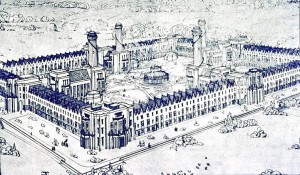 Relevant History welcomes Steve Wiegenstein, author of Slant of Light, published in 2012, and This Old World, its sequel, published in 2014. Steve grew up in the Missouri Ozarks, the setting for his novel series, and worked there as a newspaper reporter before entering the field of higher education. He is an avid hiker and canoeist who hits the trails and float streams of the Ozarks every chance he gets. Steve lives in Columbia, Missouri, but loves to speak at libraries, civic organizations, and other groups across the country. His books are available from major retailers and his publisher. To learn more about Steve’s books, check out his web site and blog. Follow him on Facebook and Twitter.
Relevant History welcomes Steve Wiegenstein, author of Slant of Light, published in 2012, and This Old World, its sequel, published in 2014. Steve grew up in the Missouri Ozarks, the setting for his novel series, and worked there as a newspaper reporter before entering the field of higher education. He is an avid hiker and canoeist who hits the trails and float streams of the Ozarks every chance he gets. Steve lives in Columbia, Missouri, but loves to speak at libraries, civic organizations, and other groups across the country. His books are available from major retailers and his publisher. To learn more about Steve’s books, check out his web site and blog. Follow him on Facebook and Twitter.
*****
Life is pretty much a mess, most of the time. People don’t behave as they should; they follow their own interests and desires, bringing them into disagreement with others and creating unnecessary heartache and conflict. Wouldn’t it be nice if everyone could agree in advance that they would act for the common good, setting aside their own wishes in favor of what’s best for everyone?
That is the essence of the Utopian ideal, and that’s why it has fascinated me for many years. I first got interested in Utopian movements when I read about the Icarians, a little-known group that lived in the United States for about fifty years in the Nineteenth Century. That interest led to a wider appreciation for the entire Utopian movement, which was a transatlantic movement inspired both by Romanticism and by the newly created idea of “social science,” both of which contributed important elements to the movement in varying degrees.
The Founding Thinkers
 When I think of the foundations of this movement, three names come to mind: Pierre-Joseph Proudhon, coiner of the memorable phrase “Property is theft”; Charles Fourier, the Utopian socialist whose concept of the “phalanx” inspired communities on both sides of the Atlantic; and Robert Owen, the Welsh reformer who put his ideas into action in Britain and the United States. The intellectual roots don’t attract me as much as the human drama, though.
When I think of the foundations of this movement, three names come to mind: Pierre-Joseph Proudhon, coiner of the memorable phrase “Property is theft”; Charles Fourier, the Utopian socialist whose concept of the “phalanx” inspired communities on both sides of the Atlantic; and Robert Owen, the Welsh reformer who put his ideas into action in Britain and the United States. The intellectual roots don’t attract me as much as the human drama, though.
The Icarians, like a lot of Utopian groups, originated with a charismatic leader who attracted a group of followers. But the Icarian movement was different from most others as well. For one thing, its founder, Etienne Cabet, hadn’t actually intended to form a settlement. He wrote a novel, Voyage to Icaria, largely to comment on the political situation in France and to keep his name in front of the French public while he served a period of exile. But the novel, in which he set forth his communistic ideas in the form of an imaginary community in the South Seas, caught the public imagination, and in 1848 Cabet found himself leading a group of immigrants to the United States to establish a real-life Icaria. The experiment was marked by equal amounts of strife and heroism, nobility and pettiness, but the last colony of Icarians didn’t disband until 1898, and their dogged persistence in trying to live out their ideal deserves our admiration, if not imitation.
The Fictional Appeal
Those of you who have read my first novel, Slant of Light, will recognize that situation as the starting premise of the book—a charismatic social reformer who founds a community, almost by accident. I depart from history at that point, but certainly one of the central themes of my book is the Utopian impulse that lives in us all, and whether that impulse can ever be realized. This Old World picks up that story after the devastation of the American Civil War, when the first wave of Utopianism died down as dreams of a radical refashioning of human nature felt to most Americans more like a cruel hoax than an achievable ideal.
Somewhere below the surface, the Utopian impulse has a dictatorial side—it’s the “I know best” impulse, the belief that life’s messes and strife could be avoided if only you would agree to what I know is best for us all. You can see hints of this impulse in the obsessive fascination with order that characterizes many of the Utopian theorists’ visions of the ideal community. Fourier’s ideal phalanx was to have 1,620 people, equally divided among male and female, and encompassing what he imagined to be all combinations of the common passions of humanity. To the social reformer, our human imperfections are a problem to be solved. But to the novelist, they’re what makes us so interesting.
The fictional inhabitants of Daybreak, the name of my fictional community in Slant of Light and This Old World, try earnestly to arrange their lives for the common good. They hold weekly meetings to vote on everything from whether to install windows in their cabins to whether to buy cloth for mourning dresses. They eat together, work together, travel together. But their communal urges keep getting thwarted by their human desires. They envy, they betray, they fall in love with the wrong people. It’s the struggle between these two sides of human nature—the desire to improve and perfect ourselves, and the desire to have what we want when we want it, regardless of others—that drew me to the Utopian experience of the Nineteenth Century as a microcosm of human nature.
*****
 A big thanks to Steve Wiegenstein. He’ll give away a Slant of Light coffee mug to someone who contributes a comment on my blog this week. I’ll choose the winner from among those who comment by Friday at 6 p.m. ET. Delivery is available worldwide.
A big thanks to Steve Wiegenstein. He’ll give away a Slant of Light coffee mug to someone who contributes a comment on my blog this week. I’ll choose the winner from among those who comment by Friday at 6 p.m. ET. Delivery is available worldwide.
**********
Did you like what you read? Learn about downloads, discounts, and special offers from Relevant History authors and Suzanne Adair. Subscribe to Suzanne’s free newsletter.
